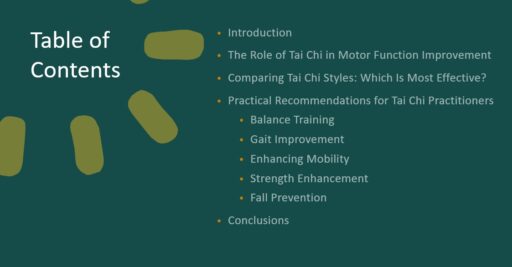As aging affects balance, mobility, and strength, maintaining motor function is key to preserving independence. A study appearing in the January 2025 issue of Aging clinical and experimental research reviewed the effects of different Tai Chi styles on older adults, offering insights into how this practice can improve physical performance.

A tutorial with details is available for ATCQA Members and Certified Instructors/Practitioners. Other people can purchase the tutorial for a small fee in our online store.
Tai Chi enhances balance, gait, mobility, and fall prevention by integrating slow, controlled movements with mental focus. The review found that Yang-style Tai Chi, particularly the 24-movement form, is the most effective for improving motor function in those with Parkinson’s disease, osteoarthritis, mild cognitive impairment, and a history of falls. Sun-style Tai Chi benefits fall-prone individuals by improving balance and strength, while Chen-style Tai Chi is useful for those with back pain. Simplified Tai Chi accommodates those with limited mobility, enhancing flexibility and strength.
For optimal results, Tai Chi should be practiced 2-5 times per week for 12-24 weeks. Specific recommendations include Yang-style Tai Chi for balance training, gait improvement, and fall prevention, and simplified Tai Chi for enhancing mobility and strength. Assessments like the Timed Up and Go Test (TUGT) and Chair Stand Test (CST) help measure progress.
By incorporating Tai Chi into their routine, older adults can significantly improve their motor function, reducing fall risk and maintaining overall well-being.